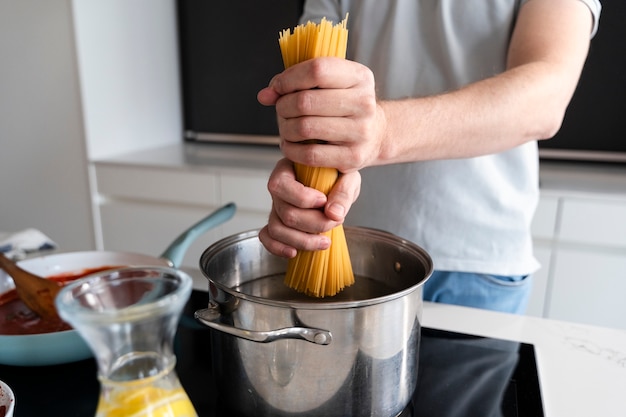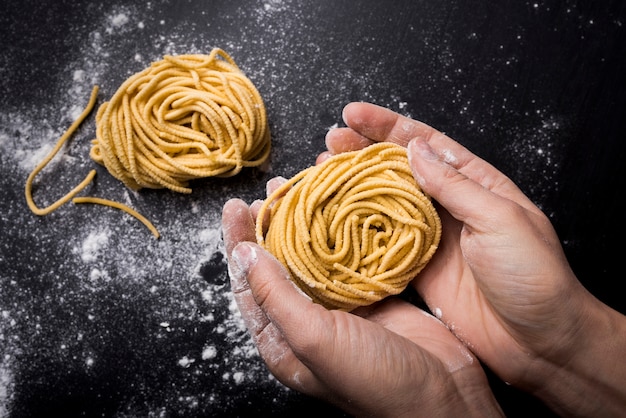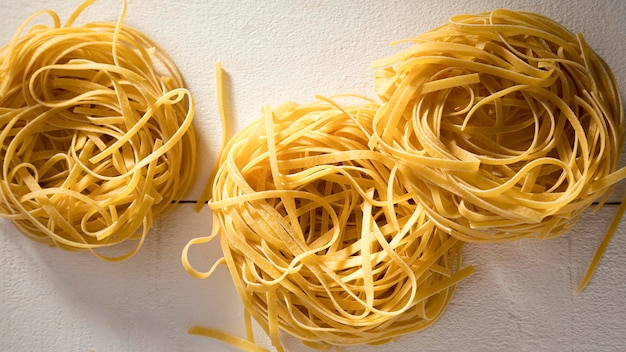Let's face it, sometimes standing in front of a pot of boiling water with a packet of spaghetti in hand can feel like a culinary mystery. How long do you boil it? Do you just wing it? I know the feeling – I've been there! But fear not, my fellow pasta enthusiasts, because this guide is your key to unlocking the secrets of perfect spaghetti. We'll navigate the twists and turns of pasta selection, explore the importance of salt (yes, it's a big deal!), and delve into the crucial art of achieving that elusive "al dente" texture.
This isn't just some boring recipe blog, though. We'll be taking a personal journey through my own pasta-making experiences, complete with hilarious mishaps and celebratory triumphs. Get ready to laugh, learn, and maybe even shed a tear or two (but only for joy, of course!).
(Part 1) Choosing Your Spaghetti: A Noodle Odyssey

Before we even get to the boiling water, we need to choose our pasta wisely. Think of it like picking the right weapon for a culinary battle – the wrong spaghetti can spell disaster.
Beyond the Basic Noodle: A World of Spaghetti Options
It’s not all about the classic, round spaghetti, you know. The world of spaghetti is full of fascinating variations that offer unique flavors and textures.
spaghetti alla chitarra: This type gets its name from the “chitarra,” a special tool that creates a square-shaped noodle with a rough surface. The result? A pasta that holds onto your sauce with a delightful tenacity.
Spaghetti Integrale: This whole wheat spaghetti boasts a richer, nuttier flavor and a slightly darker color. It's a healthy and delicious option for those seeking a more rustic bite.
Spaghetti al nero di seppia: Prepare for the dramatic entrance of black spaghetti! Made with squid ink, this unique pasta offers a subtle briny flavor and adds a touch of elegance to any dish.
Beyond the Shape: What to Look for in Spaghetti
Now that we've explored the different types, let's dive into what makes a truly good spaghetti.
Durum Semolina: This is the key ingredient that gives pasta its sturdy structure and prevents it from becoming a mushy mess. Look for pasta packages that clearly state "durum semolina" on the label.
Bronze Die: This is a traditional method of pasta production that creates a slightly rough surface, helping your sauce cling to the noodles and creating a more flavorful experience. If you see "bronze die" mentioned on the packaging, you're in for a treat.
fresh pasta: If you're looking to up your pasta game, fresh pasta offers a more delicate texture and a richer flavor thanks to the addition of eggs. It's a bit more of a commitment but well worth the effort!
(Part 2) The Salt Situation: A Salty Saga

Now, picture this: you've got your pot of water on the stove, ready to rumble. But before you dive in and start chucking noodles, we need to talk about salt. This isn't just about flavor, folks. It's about texture, and trust me, it makes a world of difference.
Why Salt is Your Pasta’s Best Friend
Think of it this way: when you salt your water, you're essentially seasoning the pasta from the inside out. The salt helps the pasta cook more evenly, maintaining its structure and preventing it from becoming bland and rubbery.
The Perfect Salty Ratio
For every 8 cups of water, a tablespoon of salt is the sweet spot. It sounds like a lot, but you'll be surprised at how this simple trick elevates your spaghetti game.
The Salt Test: A Taste of Science
Now, don’t just blindly toss in the salt. Take a moment to taste the water. It should have a faint, salty taste, almost like a light seawater. This will ensure that your pasta is cooked to perfection.
(Part 3) The Art of spaghetti cooking: A Step-by-Step Journey

Okay, the water's boiling, the salt is in, and your chosen spaghetti is ready to go. Time to cook!
Step 1: The Spaghetti Drop
With a gentle hand, lower the spaghetti into the boiling water, being careful not to splash yourself. You might notice a little foamy action happening – that’s perfectly normal and just means things are getting exciting!
Step 2: A Little Stirring Love
Give the spaghetti a good stir to make sure it doesn't stick together, forming a giant, unmanageable spaghetti lump. We want each noodle to have its own space to dance!
Step 3: Don’t Overcrowd the Party
When adding your spaghetti, be mindful of the pot’s capacity. Give the noodles enough room to swim around and cook evenly. If you're cooking a large batch, consider doing it in separate rounds to avoid overcrowding.
Step 4: Time to Check the Doneness
This is where things get a little more involved. The cooking time can vary depending on the type of spaghetti you’ve chosen, but the key is to be observant and make sure it’s cooked to perfection.
How to Check for Doneness: The Bite Test
The Bite Test is your best friend: When the spaghetti starts to feel tender but still offers a slight resistance when you bite into it, you're getting close to perfection.
How to Check for Doneness: The Drain Test
Another handy technique is the Drain Test: Grab a strand of spaghetti and hold it up to the light. If it appears opaque, it’s cooked. If it’s still translucent, it needs a few more minutes in the water.
(Part 4) The Spaghetti Timing Game: A Guide for Every Noodle
While the packaging usually provides cooking times, it's always good to have a general guideline.
Spaghetti Cooking Time Guide
| Type of Spaghetti | Cooking Time (minutes) |
|---|---|
| Classic Spaghetti | 8-10 |
| Spaghetti alla Chitarra | 6-8 |
| Spaghetti Integrale | 10-12 |
| Spaghetti al nero di seppia | 7-9 |
Remember, these are just estimates. The best way to judge doneness is by using the Bite Test and Drain Test.
(Part 5) The Quest for Al Dente: A Pasta Lover's Dream
"Al dente." It's a phrase that rolls off the tongue like a whisper of culinary perfection. But what does it really mean?
Beyond the Translation: What Al Dente Feels Like
Al dente, which translates to "to the tooth" in Italian, means the pasta is cooked through but still retains a slight firmness when bitten. It’s that magical point where the pasta isn’t mushy but also not hard and chewy. It's a perfect balance.
Why Al Dente is King
When your pasta is al dente, it holds its shape beautifully, allowing it to absorb sauce without turning into a soggy mess. It’s the key to a truly delicious and satisfying pasta experience.
Achieving Al Dente Perfection: A Few Tips
Don’t Overcook It: It’s always better to err on the side of slightly undercooked pasta.
The Bite Test is Your Guide: If you’re unsure, use the bite test. If it feels a bit too soft, it's overcooked.
Don’t Panic If You Overcook It: Even the best chefs make mistakes! If you accidentally overcook it, don’t despair. Add it to your sauce and let it cook for a few minutes to absorb some of the liquid, helping to restore some of its firmness.
(Part 6) Draining Your Spaghetti: The Finishing Touch
We're almost there! The water's been bubbling, the spaghetti is almost perfect, and it's time to drain.
Draining Techniques: Colander vs. Pasta Spoon
The Colander Method: This is the classic method. Simply lift the pot of spaghetti over the colander and let the water drain.
The Pasta Spoon Method: If you don't have a colander, use a pasta spoon to scoop the spaghetti out of the pot and into a bowl.
Timing is Crucial: Don’t Wait Until the Last Minute
Don’t delay the draining process. Waiting too long can result in overcooked, mushy spaghetti.
Avoiding Soggy Spaghetti: The Rinse Rule
Once your spaghetti is drained, resist the urge to rinse it with cold water. This cools the pasta down and makes it harder for it to absorb sauce.
(Part 7) Pasta Tricks and Tips: Elevate Your Spaghetti Game
The basics are in place, but now let's level up our spaghetti skills. Here are a few tips and tricks that can make all the difference.
Tips for a Killer Sauce
Save the pasta water: Don't throw out the pasta water! It contains starch, which can thicken your sauce and create a creamy, velvety texture. Add a splash to your sauce to enhance its richness.
Start the Sauce Early: Give your sauce a head start! Begin preparing your sauce before you cook the pasta, allowing it plenty of time to develop rich, complex flavors.
Tips for Serving Spaghetti
Don’t Overcrowd the Plate: Leave some space on the plate for the sauce to shine and create a visually appealing presentation.
Fresh Herbs are Your Friend: A sprinkle of fresh parsley, basil, or oregano adds a burst of freshness and brightness to your dish.
(Part 8) Spaghetti Stories: My Pasta Journey
Over the years, I’ve had my fair share of pasta-making experiences, some that are hilarious, some that are heartbreaking, and some that are pure joy.
Spaghetti Mishaps: When Things Go Wrong
The Time I Overcooked My Spaghetti: I’ve been there – overcooked spaghetti that turns into a mushy mess. It's a culinary tragedy that I'll never forget!
The Time I Forgot the Salt: Yes, it happened to me too. I completely forgot to salt the water, resulting in a bland and rubbery pasta that was barely edible.
Spaghetti Triumphs: When Everything is Perfect
The perfect al dente pasta: There's nothing quite as satisfying as biting into a perfectly cooked al dente pasta. It’s a culinary triumph that fills you with joy.
My Signature spaghetti sauce: After years of experimentation, I finally perfected my signature spaghetti sauce. It’s a recipe I’ll cherish forever.
(Part 9) FAQs: The Answers to Your Spaghetti Questions
Let's tackle some of the most common spaghetti-related questions.
1. How to Cook Spaghetti for a Large Group?
If you're feeding a crowd, it's best to cook the spaghetti in batches to prevent overcrowding the pot and ensure even cooking.
2. Can You Cook Spaghetti in the Microwave?
It’s best to avoid cooking spaghetti in the microwave. The pasta won’t cook evenly, leading to inconsistent results.
3. How Long Can You Keep Cooked Spaghetti?
Store cooked spaghetti in the refrigerator for up to 3 days.
4. Can You Freeze Cooked Spaghetti?
Absolutely! Freeze cooked spaghetti in an airtight container or freezer bag for up to 3 months.
5. What are Some Good spaghetti recipes?
The possibilities are endless! Try spaghetti with marinara sauce, spaghetti carbonara, spaghetti with meat sauce, spaghetti with pesto, or create your own signature sauce.
(Part 10) Go Forth and Make Some Spaghetti!
Now that you've mastered the art of cooking spaghetti, go forth and create your own culinary masterpieces. Don't be afraid to experiment, try different recipes, and find what you love best.
Remember, cooking spaghetti is a journey of discovery and deliciousness. So grab your favorite ingredients and get cooking!
Everyone is watching

Prime Rib Roast Cooking Time Chart: Per Pound Guide
Cooking TipsPrime rib roast. Just the name conjures images of lavish dinners, crackling fires, and hearty laughter. It’s ...

How Long to Bake Potatoes in the Oven (Perfect Every Time)
Cooking TipsBaked potatoes are a staple in my kitchen. They're incredibly versatile, delicious, and surprisingly easy to m...

Perfect Rice Every Time: The Ultimate Guide to Cooking Rice
Cooking TipsAs a self-proclaimed foodie, I've always been a bit obsessed with rice. It's the foundation of countless cuisi...

The Ultimate Guide to Cooking Asparagus: Tips, Techniques, and Recipes
Cooking TipsAsparagus. The mere mention of this spring delicacy conjures up images of vibrant green spears, crisp and burs...

Ultimate Guide to Cooking the Perfect Thanksgiving Turkey
Cooking TipsThanksgiving. Just the word conjures up images of overflowing tables laden with delicious food, the scent of r...
